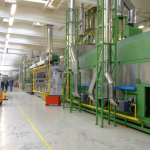The benefits of integrating robotics into your production line
Robotics in the manufacturing industry has been gaining popularity in recent years. With technological advancements and the increasing demand for efficiency, robotics has become integral to modern manufacturing.
In this article, we will explore the benefits of integrating robotics in your production line and how it can enhance productivity, increase efficiency, and improve the overall quality of your products.
Industry leaders who successfully use robotics in production
Many industry leaders have incorporated robotics and cobots (a collaborative robot) into their production lines and have seen significant benefits. Here are a few examples:
These are just a few examples of industry leaders successfully incorporating robotics and cobots into their production lines. As technology evolves, we expect to see even more companies using robotics to improve efficiency, increase productivity, and reduce costs.
Benefits of robotics in production lines
The integration of robotics in your production line can significantly increase productivity. Robots can work tirelessly without needing breaks, lunchtime, or even rest days, so your production line can operate 24/7, maximizing output. Automating repetitive tasks, such as packaging, sorting, and assembling, allows your human workers to focus on more complex tasks requiring critical thinking and decision-making. The ability of robots to work efficiently and consistently results in an overall increase in productivity for your business.
Robotics can also help improve the quality of your products. Using sensors and cameras, robots can perform inspections and detect defects faster and more accurately than humans. By identifying and removing defective products early in production, you can reduce waste and prevent costly product recalls. Robots can also monitor the production line to ensure all components are assembled correctly and that the final product meets the required specifications.
Workplace safety is a top priority for any manufacturing company. The integration of robotics in your production line can help reduce workplace injuries and accidents. Robots are designed to perform hazardous tasks such as heavy lifting and welding, which reduces the risk of injury to human workers. By using robots for these tasks, you can also improve the overall ergonomics of your workplace, reducing the risk of repetitive strain injuries and other musculoskeletal disorders.
Robotic automation can also help improve the efficiency of your production line. By automating tasks, you can reduce cycle times and increase throughput. Robots can also work at a consistent pace, which means that the production line can operate at a steady rate without the need for slowdowns or stoppages. By improving the overall efficiency of your production line, you can reduce lead times, increase customer satisfaction, and, ultimately, increase profits.
Finally, integrating robotics into your production line can help you save costs. While the initial investment in robotics can be significant, the long-term cost savings can be significant. Robots can work around the clock without the need for breaks or rest days, which means that you can reduce labor costs. By automating repetitive tasks, you can also reduce the risk of human error, which can result in costly product recalls. With the ability to work efficiently and consistently, robots can also help reduce energy costs, increasing cost savings.
Integrating robotics in your production line can bring numerous benefits to your business. From increased productivity to enhanced efficiency, robotics can help you improve the quality of your products, reduce workplace injuries, and ultimately, increase profits. As technology continues to evolve, robotics will undoubtedly become even more advanced, bringing new possibilities for manufacturers. Whether you are a small business or a large corporation, integrating robotics into your production line can help you stay competitive in a rapidly changing market.







